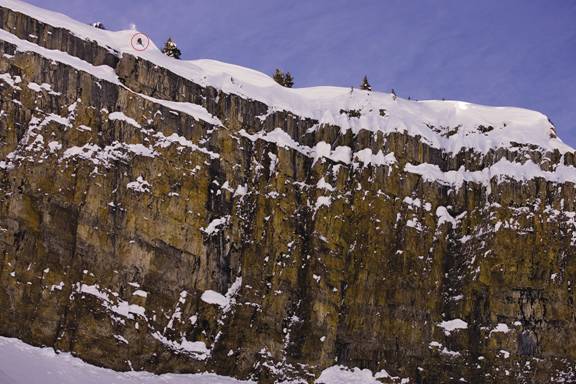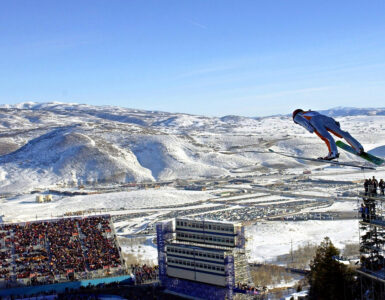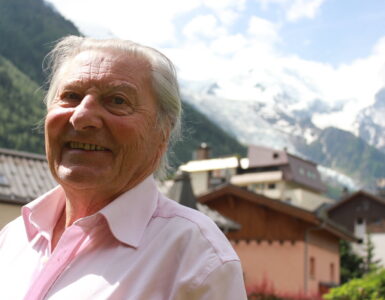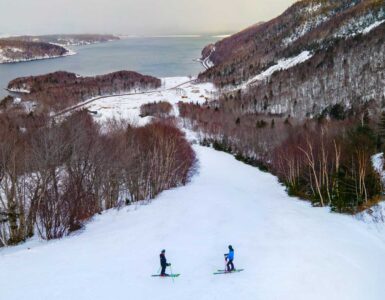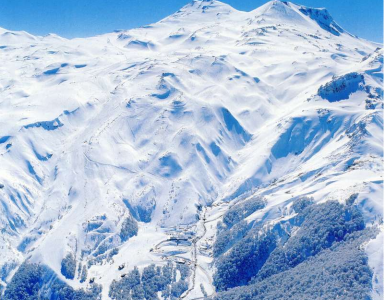Everybody knows the moment. That point at which time fades away and you find the space between your thoughts, and everything feels perfect because everything becomes nothing.
Zen Buddhists find the moment by sitting cross-legged for hours, practicing not-thinking. Cyclists spin circles. Surfers find the balance point. You do it your own way—maybe jog or do yoga or catch the early tram for first tracks.
Or you do as Jamie Pierre does, and you step into a pair of 185 Pocket Rockets, tuck your shoulder-length hair under a Dakine skullcap, stare down your Gallic nose at an inrun in Utah or Colorado or Switzerland—and ski headlong off a cliff. No parachute. You don’t even land upright. Just an oafish thud. Full stop. Boof! Eighty-five feet. Double that—bigger is better. You do Lincoln loops and back flips and Lincoln loop—back flip combos. Land on your rib cage or your spine or your head. You scare the crap out of your loved ones and alienate yourself from your peers and you do it for the astonishingly meager fee of $20,000 a year, health insurance not included.
Must be one helluva moment.
But it’s not that simple. To tap into the moment, Jamie Pierre—style, you must first engage in three decades of self-destructive behavior. You drop from the womb in a Minnesota hospital in 1973 and piss in the doctor’s face. You take everything personally and throw fits. You pick up a bong at age 14—and don’t put it down for 15 years. You drink to excess and get surly. Learn to ski, finish high school, move to where the mountains are big. You begin skiing off cliffs, right about the time people start calling it “hucking. You go higher than anyone else. You talk all kinds of shit and pitch ever-bigger tantrums and cultivate your rep as a bad boy. Turn pro, make appearances, get loaded. Pass out and black out and wake up and make yourself puke and huck another cliff and do it all over the next day, and the next, until all of sudden you’re 30 years old and half-broke, flopping around on the living room floor, biting your tongue and lips until the blood flows.
You turn to God, which works—but only to a point. So when you’re not munching communion wafers and sipping Jesus juice, you’re hurling your scrawny body off cliffs. Any size—80 feet or 185. Each monster huck produces the moment, that ethereal whoosh that for a nanosecond strips away all that matters. You land without incident. Now you feel as though God is looking out for you, which makes you feel safe.
Never mind that God’s trying to make corn grow in Somalia.
Never mind that the moment could be your last.
People warned me. They said, Oh man, you don’t want to write about Jamie Pierre. Pierre’s a pain in the ass, he did this. Pierre’s a punk, he did that. Pierre gets props only because he goes bigger than everyone else. They wouldn’t shut up about him—guy’s hit his head so many times he gets seizures. And besides, he’s a Bible thumper. Don’t waste your time.
Here’s a guy who gets ski-movie audiences fired up in one- to four-second snippets. A guy the resort PR people refuse to talk about on the record because they’ve run out of nice things to say. So off I went to Sandy, Utah, at the base of Little Cottonwood Canyon, to learn whether stupidity or some enviable state of enlightenment compels a man to click into a pair of skis and risk exploding like a dropped egg.
In the five days I spent with Pierre, we ate tacos and fish burritos at Lone Star. We skied together at Alta and Snowbird. He took me on the Cliffs-I’ve-Hucked tour. I spent hours in the 700-square-foot converted garage apartment he rented with his then fiancée (now wife), Amee. Thumbed through his books (sample titles: The Purpose-Driven Life and the New Living Translation of the Holy Bible—Easy to Understand/Relevant for Today). Admired his Neil Young collection. Got to know his dogs (Mr. Bear, lab mix, 10; Noa dalmatian, seven). Sushi at the mini mall, French toast at the Porcupine. Church on Sunday. And more than once during those five days, Jamie looked at me with his desperately sad brown eyes and tried to explain his dangerous preoccupation. “At first I did it for fun, he’d say, “then I did it for fame. And now? “It’s work. I love to do it, but sometimes I don’t know if it’s worth it.
But hucking off cliffs feels good, and Jamie wants to go bigger—even though he’s almost 33 and has a kid on the way and is as famous as he’ll ever be. In fact, he’s got his sights on a 240-footer in the Grand Targhee, Wyoming, backcountry—a world record. That’s 20 feet higher than the Golden Gate Bridge. People jump from the Golden Gate Bridge in order to die. One evening, Jamie looked to the sky for a thought as his fish burrito went cold, and said: “I have this reputation of being Mr. Goes the Biggest. Sometimes I laugh and wonder, ‘What have I created?”
Pierre did piss in the doctor’s face. His mom told me in a letter, written on the family stationery. Pam Pierre. Nice lady. Makes you wonder how Jamie, third in a wholesome, unbroken eight-child family from Minnetonka, could have been so insubordinate. But talking to Pam makes it clear how Jamie can be so gosh-darn polite these days, thanking you repeatedly for a bag of chips or, for that matter, taking interest at all. Talk to Pam, and you’ll see exactly why Jamie answers the phone with a “Good morning or a “Good afternoon, why he kisses Amee between bites of sushi, why he’ll spoon with his dogs in front of a reporter.
Gerard Pierre, a native of Aix-en-Provence, France, moved to Pam’s Minnesota after the two met while she was studying in France in the ’60s. Along came the kids: Chris, Ben, Jamie (technically he’s Matthew Jamison Fredric Marie), Sarah, Naomi, Jon, Andrew, and Michael. Life was sitcomlike. Pass the salt. So-and-so’s poking me. Go ask your father. Put on your pajamas. The Pierres went to Grace Lutheran on Sundays. They took outings and pictures. When Pam and Gerard dropped the kids at Buck Hill in the early ’80s, it was only a matter of time till Jamie started hucking, albeit off manmade snow whales. The kid was onto something. He felt at home in the air.
By his early teens, Jamie also felt at home with a lungful of pot smoke. “From the time I was 14 it was my goal to be high all the time,” Jamie recalls, an undercurrent of regret in his voice. “I was trying to numb myself. All regular kid stuff, yes, because when you’re 14, feeling numb means feelin’ good. But Jamie didn’t stop, and every time the anesthetic wore off, his adolescent chemistry bubbled over in anger and destruction. Break some shit. Light the marsh on fire and run away. Get in coach Peterson’s face, even though he lives down the street and his son Blake is your best friend. “He was so frantic all the time, Pam Pierre told me. “I always said to him, ‘Jamie, when you get yourself in a big fat hurry, you can get hurt, or hurt someone else.’
Pam and Gerard squelched Jamie’s idea to go to Mexico one spring break. Cheap tequila shots. Tijuana ditch weed. Cops with dripping yellow fangs. Bad idea. But why not visit your brother Chris in Crested Butte, near Gunnison, where he’s studying at Western State College? Now there’s some good clean fun.
And so Jamie eventually landed in CB after graduating from Minnetonka High, class of ’91. He spent his days showing off for his big bro. Chris was a hucker, too, and together they created their own map of Crested Butte, a series of rock drops that happened to be linked by actual trails. Five feet led to 10 feet led to 40. And then Jamie and Chris headed to Utah.
1999. The plaza at Snowbird. Freeskiing’s Frontier-land. Everyone’s here. Jamie’s slinging pizza when he picks up his first high-profile sponsor, Dakine. Now he can talk more shit. Jamie Pierre is the one getting paid to ski. Jamie Pierre is the one making magazine appearances and getting recruited for ski films. Jamie Pierre has the balls to launch it.
Over the next few years, Jamie’s résumé grew. Salomon skis and boots, Leki poles, Dragon Optical, a handful of others. He appeared in films by Matchstick and Rage and Teton Gravity Research. In TGR’s release, High Life, Jamie became the first to huck Wolverine Cirque, a 165-footer in the Alta backcountry. The monologue in that sequence sums up Jamie’s worldview circa 2003. “All it takes is sacking up, he says to the camera between tough-guy swigs from a champagne bottle. “You could do it, too. All you have to do is try, you fuckin’ pussy.
“I saw Jamie behave in really destructive and bizarre ways,” says Utah-based photographer Fred Foto, who’s known Jamie for nearly 10 years. “He’d huck some cliff and ring his bell, then disappear into the woods for an hour without letting anyone know why. Or he’d wreck his car and just brush it off like it was nothing. One time he was driving some friends and me in Idaho. He said he was sober. But then we got pulled over, and Pierre just gets out of the car and runs across this farm. We didn’t hear from him for days.
Ask anyone around Little Cottonwood—lifties, photographers, pros, resort managers—and they’ll tell you the same, some of it firsthand, a lot of it hearsay. Pierre made people uncomfortable, in particular Snowbird ski patrol. He’d ignore slow signs, flip the bird to patrollers. Finally they pulled his pass.
All the while, he continued his campaign to smoke and drink himself into a perpetual state of numbness. “When I first met him (in 2002) we were both partyers, says Amee. “He’d get blackout drunk on hard alcohol, then in the morning he’d make himself throw up, and take five bong hits—before he had his coffee.
That’s when the seizures began. The kind where your fingers get tingly and you get light-headed and nauseated and then your body shakes and convulses, your teeth bearing down on your lips and tongue. Maybe you collapse. Get a black eye. Which is exactly what happened to Jamie right after he met Amee. “I hadn’t heard from him for a few days, she told me as we drank coffee one morning. “When I finally found him, he had a bitten lip and a bruised eye. It was terrifying. People told Amee that Jamie was broken. But as someone who’d spent a decade working with developmentally disabled adults, she couldn’t walk away. She saw Jamie as a fixer-upper.
In 2003, Jamie went back to Minnesota for tests. Sleep deprivation. Strobe lights. MRIs. CAT scans. Doctors found no evidence of brain injury or head trauma, despite the dozen or so concussions he’d sustained over the years from landing on his dome. No epilepsy, either. So they told him to lay off the chronic. And quit after one drink.
He did. The seizures stopped. And he accepted the Lord Jesus Christ as his savior—embracing Christianity in a way he was unable to as a churchgoing Minnesota grom. Jamie was baptized on May 23, 2004, by Pastor Jeff Nellermoe at Good Shepherd Lutheran, in Sandy. Meaning, no, he’s not a born-again, like everyone says—he just found his God, which in part entails believing that there’s life beyond hurtling toward earth from a hundred-odd feet. One Sunday, after excusing himself to take communion, he rejoined me in a back pew at the Good Shepherd and said, “Religion gives me something to live for.
Maybe there is a God looking out for Jamie Pierre. In 2003, when he made the inaugural huck of Alta’s Wolverine Cirque, he dropped 165 feet. The inrun was 35 degrees, the landing 40 degrees. He approached the edge at about 15 miles per hour. He was in the air for no more than three seconds, during which time his 165-pound frame reached roughly 50 miles per hour—a speed that requires you to land tails first, and then absorb the impact by bending your knees, sitting back on your butt, and taking the remainder of the hit with your back. And the landing zone has to be just right—not blower powder, but a layered snowpack with some breakable crust three feet down, and another couple of feet beneath it that can cushion the blow of more than 2,000 pounds of pressure. Once, after landing an 80-footer inbounds at Alta, Pierre’s forward momentum caused him to tunnel under the snowpack for 10 feet and pop out of the ground, like a porpoise out of the ocean; the surface snow between his entry and exit was untouched. But that’s unusual. Most of the time, Jamie just excavates a “bombhole. Sometimes he bounces a foot or two before coming to a complete stop. And if the snow isn’t right? Then things get ugly. Shattered ankles and knees, femur-shoved-through-pelvis, crushed rib cage, internal bleeding, punctured lungs, broken neck or back, skull fracture. Or the life gets knocked out of you on impact. Not for Jamie, though, as he explained to me just above Mark Malu rocks, a 130-footer inbounds at Snowbird, which he hucked before they blacklisted him. When he finds himself alive at the bottom of a cliff, he told me, it’s because Jesus provided him with “the tools.
Most skiers quit going huge once they’ve grabbed the attention of sponsors. They stick to the 60- and 80-footers, the stuff they can ski away from. Most people, in other words, come to their senses. Extreme skier Scot Schmidt figured out in his early 20s that free-falling at 50 miles per hour all but guaranteed his premature demise. “It was the mid ’80s, and I skied off Beck’s Rock at Squaw, which is over a hundred feet, he recently told me. “I decided right then, in the air, that this was as high as I ever wanted to go. I thought, ‘What did I just do? I’ve killed myself.’ But Schmidt, now 44, is no stranger to the moment, the mental acuity that free-falling can bring. “I’ve had that experience where you transcend time—there’s this sensory overload, your life is about to end, and you’re so conscious. You become this superbeing.
Or you don’t. Schmidt recounted the story of Paul Ruff, a Tahoe ripper who launched off Glove Rock in the Kirkwood, California, backcountry in 1993. Ruff plunged more than 140 feet, came up eight feet short, landed on his back on a ramp of rocks, and died. “He’s a test dummy, Schmidt said of Pierre. “I’ve seen a lot of crazy stuff over the years, but he goes beyond that. You just can’t anticipate when the wind might grab your skis and flip you upside down. There’s no room for error.
Until last spring, when he split his head on his ski tail at the bottom of an 80-footer, Jamie hadn’t sustained a serious injury. Not when he launched Mark Malu rocks. Not at Wolverine Cirque. Not at 100-foot Rock Springs Cliffs, near Jackson, Wyoming. Not while gap jumping an Oregon highway for the cover of this magazine’s March 2005 issue. He didn’t even get hurt at Engelberg, Switzerland, in 2004, when he dropped a 185-foot cliff and landed where the snow was barely covering some rocks. A scraped back protector, yes. A scary, motionless moment that caused Amee to break down in tears the second he went over the edge, yes. Real injuries, no. Unless you count the concussions, which Jamie does not. He doesn’t wear a helmet, either. “If something’s so dangerous it requires a helmet, then maybe I shouldn’t be doing it, he told me. “I know it’s hard for people to understand, but I’ve learned through experience what is reasonable.
A framed print on Jamie’s bathroom wall reads: “The challenge is to be yourself in a world that is trying to make you like everyone else. By age 32, other pro skiers are mellowing out, starting their own companies, becoming elder statesmen. But while other pro skiers—and the rest of us—can find peace of mind by more conventional means, Jamie cannot. “There’s some combination of neurotransmitters, a cocktail that he cooks up when he’s skiing off cliffs, Dr. Nate Zinsser, a sports psychologist who works with combat soldiers at West Point, recently told me. “Putting his life on the line gives him an elevated awareness and sense of perception. And if he doesn’t get that, he feels like shit. I’ve seen people go through withdrawal—Special Forces and Delta Forces who have a sense of dullness outside of their operations. This guy Pierre is just like that point man on a patrol, said Zinsser. “He’ll either find the wire—or trip over it.
So it’s winter again, and you’re Jamie Pierre, taking in the view, anticipating the moment. You’re on top of a cliff, maybe in Little Cottonwood or Andermatt, or if the stars are aligned and the snowpack is just right, you’re staring down that 240-footer in Wyoming. A dozen people are there—magazine photographers, a film crew, some locals. Maybe your wife, if she can stand to watch. It’s a long drop all right, but you tune everything out, visualize the landing, say a Hail Mary, and point ’em. Your skis run nicely. You gain speed. The edge draws nearer. Everything comes into focus in a way you can’t attain through church or family or drink or smoke or love. Your tips go over, then your tails—and you’re airborne. Whoosh.
In three seconds, maybe four, you’ll hit the ground. Live or die. Find the wire or trip over it. But right now, none of that matters. Right now, you’re in the moment.
This story ran in the December 2005 issue of Skiing. It made the Notable List in Best American Sports Writing 2006.
By Mike Kessler, http://www.skinet.com/


